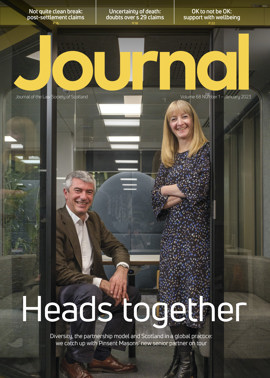Risk: More than just a message

One of the most memorable lines in the 1967 film Cool Hand Luke is uttered by Captain, the warden in charge of a Florida prison camp. Used as an explanation, or justification, for his actions in losing his temper and resorting to physical violence, Captain explains to the prisoners that what they are seeing is “failure to communicate”. The clear implication is that the title character, Luke, is at fault and has brought a physical beating upon himself.
Clearly, in the context of providing legal services, any failure to communicate is a situation which practitioners will seek to avoid. It could be argued, however, that to prove effective, communication needs to be a two-way process. In the context of managing expectations, whether between solicitors and their clients or between solicitors themselves, this would seem to be especially true. As with any process, the quality of information or input provided is inextricably linked to the quality of the end result.
We know that poor communication is often cited as a leading source of complaints to the Scottish Legal Complaints Commission, and it is clear that effective communication is essential in managing client expectations. By setting clear goals, being transparent and actively listening to any concerns, solicitors can build trust and foster a positive and fruitful working relationship, leading, in turn, to better outcomes for both solicitor and client.
The need for good communication is not just limited to our dealings with clients and other third parties. Effective communication is the lifeblood of any organisation, and the way we communicate within our own firms and organisations can have a huge impact on workload, time pressures, efficiency, and staff morale/wellbeing.
Communication is central to the effective performance of a solicitor’s role, but is not something on which in-depth training is regularly provided, and professionals can find it difficult. When done poorly, this can lead to misunderstandings and dissatisfaction. A regular refresher on points to bear in mind when it comes to communication can, therefore, represent a key aspect of any organisation’s risk management strategy.
What do we mean by communication?
In the context of providing legal services, communication is more than simply conveying a message. It is often a two-way process which allows an interchange of information for the purpose of determining next steps or the best way forward.
Recipients of advice or information can often make assumptions based on their own perceptions of the sender’s communication style, and an impression can be gained based on how direct the sender is in expressing views, and the extent to which consideration is given to the recipient’s own opinions.
Legal advice can be required by any person, from any background, and it needs to be easily received and accurately understood. Consideration must always be given to the recipient’s level of understanding and the most appropriate mode of communication. In order to communicate effectively, we must, to a certain extent, put ourselves in the recipient’s shoes. The quickest or easiest option sometimes fails to yield the desired result, and we no doubt all have experience of receiving correspondence where the overall tone has seemed curt or rude, regardless of whether this was the sender’s intention.
Promoting clear and effective communication
Clients or colleagues can feel shortchanged if the communication they receive leads them to feel undervalued or in the dark about what is going on. In order to avoid alienating the recipient, or creating a belief that we have not taken the time to communicate properly, we must invest in the right medium to achieve the desired result. For this reason, one of our first considerations when attempting to communicate advice, or a message, must be to decide which medium is best for the task at hand.
Oral communication – e.g. meetings (virtual or in person) and phone calls – can be helpful when immediate feedback is needed, or if there is a personal dimension to the message which is to be conveyed. Written communication, on the other hand, is sometimes a more appropriate choice when words need to be chosen carefully, when a formal record is required, or when the message is likely to need detailed consideration. Essentially, a judgment call needs to be made regarding the nature of the message and the desired relationship and/or anticipated form of response.
When applicable, the non-verbal elements of communication (tone and body language) can be of critical importance – not in the sense of denying the significance of the words used, but rather in highlighting how important it is that any non-verbal elements are compatible with what we are trying to say, rather than giving out mixed messages.
Effectively managing expectations
The following points are provided as suggested hallmarks of effective communication in managing expectations, whether that be the expectations of our clients, or the expectations of our colleagues.
Listening to understand
First, seek to understand fully, for yourself, what is being asked – whether this is something being asked of you as a provider of legal advice, or something you will be asking of your intended recipient – and build a full picture in your own mind. Once questions have been posed, it is only by carefully listening to and considering the responses that we can be clear on what is being asked. We all know the risks involved in making assumptions, but we can be equally guilty of doing just that when faced with the everyday pressures of work.
Questions are used for a variety of reasons – to gather information, stimulate thought and discussion, explore attitudes and ideas, solve problems, and/or clarify your own or someone else’s thinking. The quality of the answer you get will, to some extent, depend on the quality of the questions you ask.
Agreeing expectations
Provision of legal advice is a service, and it is tempting to say “yes” promptly when asked to assist by a client or colleague. It ought to be borne in mind, however, that in doing so we may end up shortchanging both ourselves and our clients or colleagues. Setting realistic targets, and agreeing with your contact what they can expect – rather than telling them – helps to ensure “buy in”, and confirms that your working relationship is a two-way street.
Overpromising and underdelivering erodes trust, so planning for contingencies is a positive way to ensure positive results. If what you are being asked is simply not going to be possible to achieve, figuring out what the larger objective – and the recipient’s priority – is, can assist in providing a solution-focused and positive service, while delivering an answer which is grounded in reality. Setting clear, realistic goals, combined with provision of regular updates, can help prevent misunderstandings and ensure that the recipient understands what they can expect from you.
Overcommunicating
Overcommunicating keeps your recipient in the loop and, when coupled with early provision of information, minimises the risk of surprises. Most people would rather get disappointing news early, so that they can attempt to find solutions. Regular communication allows your recipient the choice to review and consider the message which is being transmitted. They may, following consideration, decide that what is being said is not relevant or is unnecessary for their purposes, but failing to communicate the message in the first instance takes that choice away.
The points noted above are all equally applicable in the context of (a) client care, and (b) ensuring efficient delegation of tasks internally. In the legal world, as with many other professions, the remote or hybrid working which became essential during the Covid-19 pandemic is here to stay. Considering the three points noted above could well assist in ensuring that solicitors adapt to this way of working, and protect against the possibility of communication breakdown. In a world where supervision, in particular, is often carried out in a more remote manner than previously, it is imperative that timeous and effective communication is maintained, to ensure that client needs are met and that less experienced employees feel supported and confident in asking for assistance when needed.
The above comments are offered in the hope that something may resonate. The feeling of being stretched under pressures of work is one which is familiar to most solicitors; however, prevention is always better than cure. Taking the time to ensure effective communication now is ultimately far preferable to dealing with the fallout if, or when, issues arise further down the line.
It is perhaps fair to say that the suggestions noted in this article propose nothing particularly new. However, mindful of the new year and the opportunity to refresh and re-centre our risk management techniques, and in the words of Cool Hand Luke himself, one might also be forgiven for observing that, sometimes, “Nothing can be a real cool hand”.
Regulars
Perspectives
Features
Briefings
- Civil court: Costs – the tail that wags the dog
- Licensing: Keeping alcohol out of sight
- Planning: A framework for sustainability?
- Insolvency: When is a creditor not a creditor?
- Tax: A new, improved autumn statement?
- Immigration: First stop Rwanda?
- Scottish Solicitors' Discipline Tribunal: January 2023
- Civil court: Expenses – barred by delay?
- Property: Transparency, human rights and the registers







